According to the WHO, every second person on the planet is infected with helminths every year. Many people think that parasitic worms are not very harmful to health. However, not everything is so simple: helminths can infect important internal organs: heart, lungs, brain.
Helminths - who are they?
Helminths are parasitic worms that can choose the body of a human, animal or plant as their host. There are only three types of helminths:
- ribbon worms.This class covers 3, 500 species of helminths. The length of parasitic worms varies from a few mm to 10-15 meters;
- wing.The parasites got their names due to the presence of pacifiers with the help of which they received nutrients. The human body can be infected with about 4 types of flat fluke. As a rule, the length of the worms does not exceed 5 cm;
- round worms.This class of helminths has more than 24, 000 species. Roundworms are spindle-shaped. In general, their length does not exceed 0. 5 meters.
You can get helminths in different ways. However, in most cases, parasite invasion occurs for the following reasons:
- Poor hand hygiene.
- Unwashed vegetables, fruits; undercooked or undercooked meat, fish - the use of such products repeatedly increases the risk of parasitic infections.
- Keeping food open outside the refrigerator. Insects can transfer helminth eggs to food stored without packaging.
- Keep in touch with pets.

The main symptoms of the presence of parasites in the body:
- nausea, vomiting, diarrhea;
- lose weight;
- allergic rashes;
- swelling;
- itching in the anus;
- break your teeth in a dream.
What are the most common helminths in Russia? Consider the most common types of parasitic worms and the diseases they cause.
Black worms
The body of the tapeworm consists of 3 to 5, 000 members. The main element of helminth fixation is the head, the additional ones are suction cups and hooks.
The most common causes of tapeworms are:
- diphyllobotriasis;
- teniarinhoses;
- teniasis.
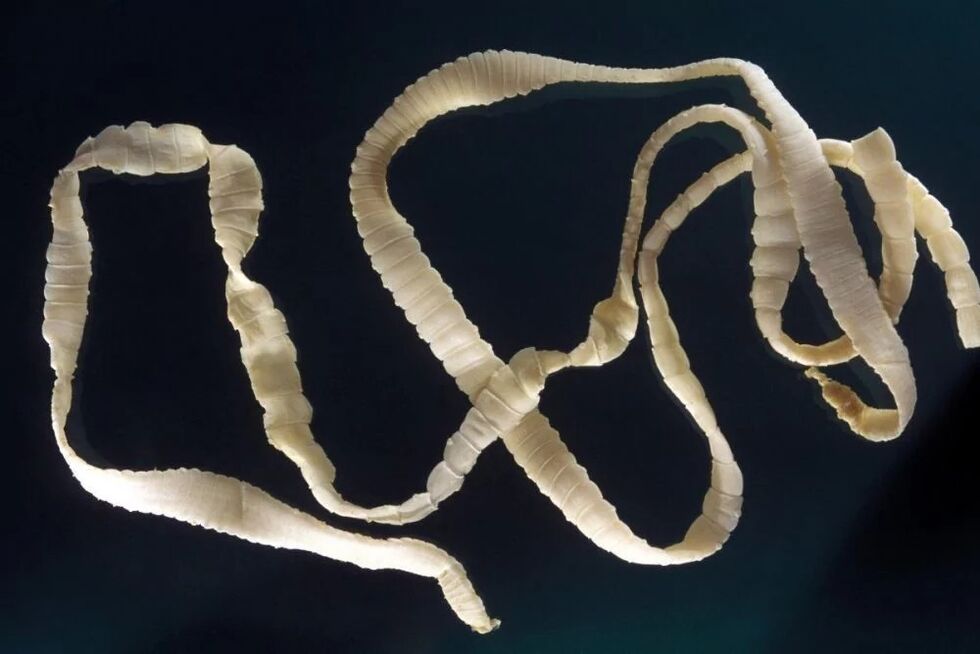
Difillobotriasis
The causative agent of the disease is a large tapeworm that affects the human intestine. Worm eggs develop in fresh water. The scheme of the tapeworm entering the human body is as follows:
- The wolf's eggs are swallowed by crustaceans living in the reservoir.
- Infected crustaceans are eaten by fish.
- A person becomes infected with a parasite by eating fish that has undergone sufficient heat treatment.
Symptomatology of the disease develops 1. 5 months after infection. The main symptom of the pathology is the presence of whitish particles of helminth in the stool.
The tapeworm, which attaches to the intestinal mucosa, absorbs large amounts of vitamin B12. For this reason, people with diphyllobotriasis often develop anemia. In addition, tapeworms can cause an increase in liver, spleen, intestinal obstruction.
Teniarinhoz
The causative agent is bovine tapeworm, which lives mainly in the human small intestine. During the developmental period, the helminth replaces two hosts: intermediate cattle, mainly humans. The cow tapeworm lives in the body for 20 years, multiplies and harms health.
Typically, people develop teniarinhosis after eating undercooked or undercooked beef.
The disease often persists without obvious symptoms and is detected by chance when a person sees helminth elements in their feces. In some people, in addition to the main symptoms of helminth infection, pain syndrome may occur on the right side of the anterior abdominal wall.
Adult helminths can penetrate the appendix, pancreatic duct, bile ducts, and provoke acute inflammatory processes. With multiple parasitic infections, intestinal obstruction may develop.
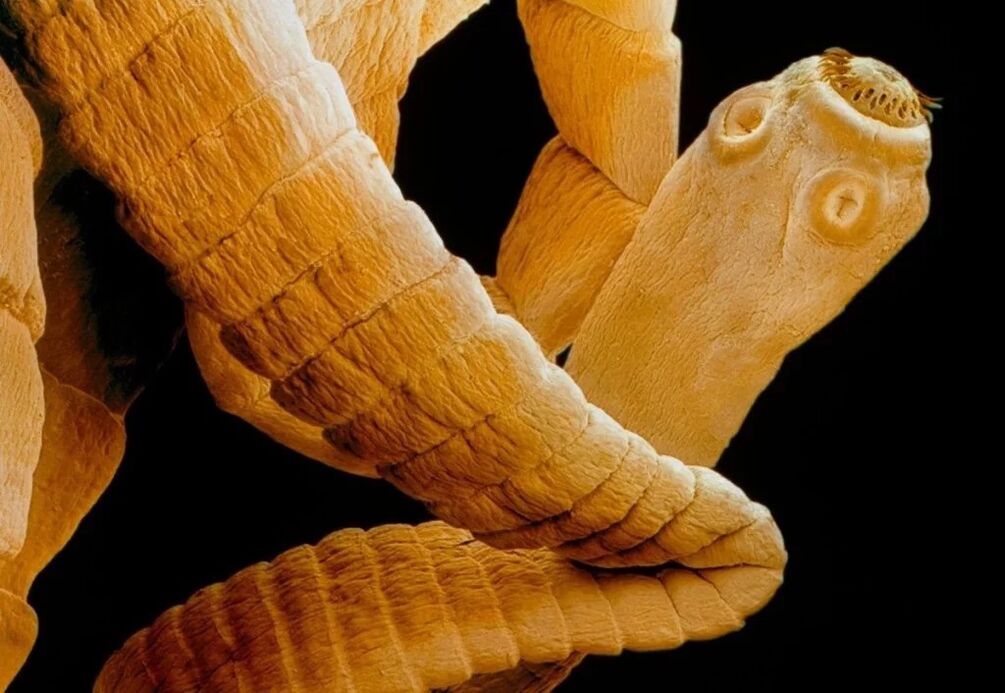
Teniosis
The causative agent of the disease is the pork worm, which primarily affects the human small intestine. Infection in humans is caused by eating raw or undercooked pork.
The parasite can penetrate various organs and tissues, causing pain in the abdomen, spine and limbs. The pathology is most favorable when the worm is localized in the subcutaneous fat and skeletal muscle tissue. When worms penetrate the eye muscles, they cause a decrease in visual acuity, lacrimation and photophobia. Defeat of the pig chain of the brain can be fatal.
Suckers
Flukes are leaf-shaped and have the ability to reproduce at different stages of life. Reproduction of worms is possible not only sexually through fertilization, but already. In addition to absorbers, worms have many hooks and thorns because they attach securely to the mucous membranes of the organs.
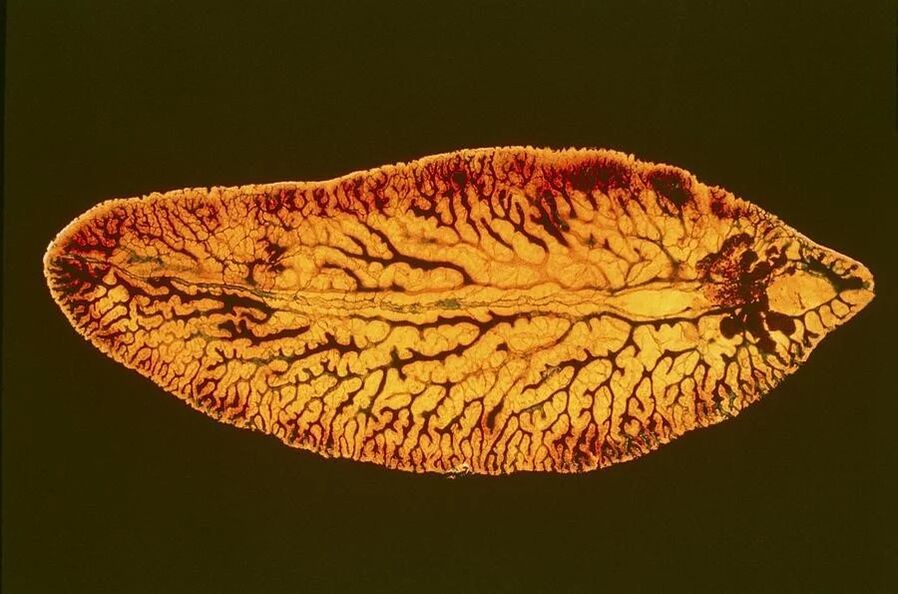
Common pathologies that cause accidents:
- fasioliasis;
- opisthorchiasis;
- paragonimiasis.
Fasioliasis
Fascioliasis occurs when the liver or gallbladder is damaged by liver fluke. The infection mainly occurs when eating vegetables that use water from open reservoirs.
In addition to the symptoms of a standard parasitic infection, a person may experience asthmatic attacks accompanied by shortness of breath, redness of the face, enlarged pupils, and tachycardia. If an adult has obstruction of the bile ducts, obstructive jaundice develops. Pathological symptoms:
- cramping pains in the right hypochondrium;
- yellowing of the skin;
- temperature;
- colorless feces.
Opisthorchiasis
The causative agent of the disease is a cat with wings. The name of the parasite is associated with the fact that in addition to humans, it often infects cats and other mammals that eat fish.

As a rule, cat litter affects the liver and pancreas and causes inflammation in the organs. Symptoms vary and depend on the number of parasites. The patient may experience:
- signs of intoxication;
- temperature;
- hives;
- itchy skin;
- pain in muscles, joints, right hypochondria.
In some cases, helminths cause an increase in lymph nodes and the development of jaundice. Chronic pathological form often causes hepatitis, cirrhosis of the liver.
Paragonimiasis
The culprit of the disease is a lung flu that enters the human body with infected crustaceans.
The parasite first enters the human intestine, then the abdominal cavity. The end point of the journey is the lung tissue. In addition, the worm can penetrate the brain and affect the central nervous system.
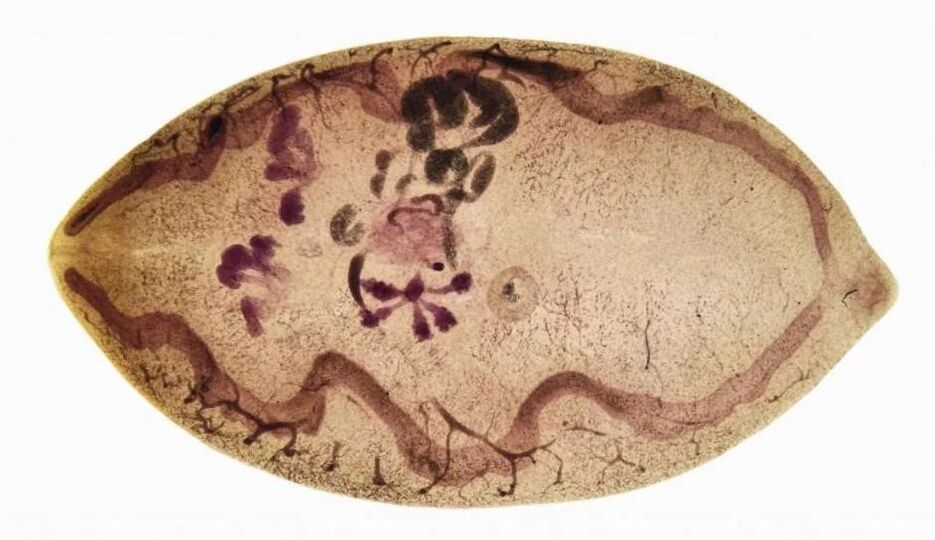
Specific symptoms of parasitic invasion of the lungs:
- chest pain;
- cough with pus and bloody sputum;
- temperature.
In some cases, helminths cause impaired lung function and gas exchange during respiration.
Roundworms
Due to their structure, roundworms (nematodes) can survive even in extreme conditions. Their bodies are covered with a three-layer muscular sac that reliably protects the parasites from external influences.
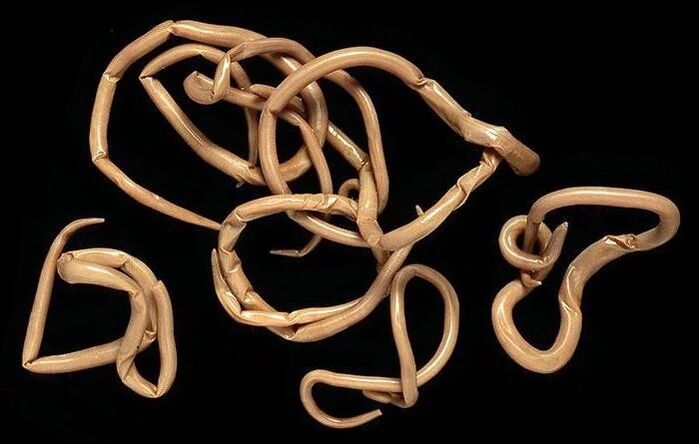
Common diseases caused by nematodes:
- ascariasis;
- enterobiasis;
- trichinosis.
Askariaz
The development of the disease first causes ascaris, which is fixed in the small intestine. The average length of an adult is 40 cm. The larvae of the parasite can enter the human digestive system with unwashed vegetables and fruits and contaminated water. In addition, poorly washed hands before eating are often the cause of ascariasis.
When larvae enter the human body, a cough with subfebrile fever, allergic rashes and clear sputum may be observed. Symptoms of the intestinal stage of ascariasis (diarrhea, abdominal pain) are observed in the presence of only a few parasites. As a rule, living in the intestines of a worm is asymptomatic.
Complications with multiple parasitic infections:
- obstruction of the bile duct;
- purulent inflammatory processes in the gallbladder, liver;
- inflammation of the appendix;
- intestinal obstruction.
Enterobiasis
The provocateurs of the disease are pinworms - small worms up to 1 cm long. Helminths penetrate the human digestive system like roundworms.
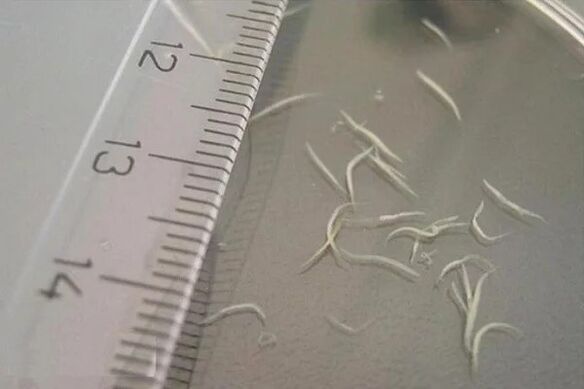
Currently, enterobiasis is the most common parasitic pathology in the world. The disease is usually diagnosed in children under 10 years of age.
Symptoms, as in previous cases, develop only with multiple parasitic infections. Children often have diarrhea, mucus in the stool, difficult and painful digestion, itching in the anus and nausea. With a severe course of the disease, there may be limb cramps. In addition, pinworms can penetrate the genitals, which also causes acute inflammation in them.
Trichinosis
This disease is caused by Trichinella, one of the smallest parasitic worms. The length of the parasite is rarely more than 4 mm. In the larval stage, worms can damage skeletal muscles. The exception is the myocardium - the muscle tissue of the heart. Adults parasitize the small intestine.
As a rule, human infection occurs when eating half-cooked pork. At the same time, it is enough to consume only 30 g of meat affected by parasites for the development of the disease.
Pathological parasitic fever manifests itself with standard symptoms. At an advanced stage, swelling of the eyelids, face, arms and legs, pain in the lower back, and masticatory muscles may occur. Possible complications are complete or partial loss of mobility, airway paralysis.
How to prevent helminth infestation?
To reduce the risk of infection with parasitic worms, it is important to follow these guidelines:
- Wash your hands thoroughly before eating after walking on the street or in public places.
- Follow the right technology to cook meat and fish. Heat treatment of meat and fish products should last at least 20 minutes.
- Do not eat dried or dehydrated fish.
- Carry out deworming of pets.
- Get tested regularly, even if you do not have any pathological symptoms. The most common diagnostic methods are macroscopic and microscopic examination of feces. The first method allows you to detect adults, the second - the eggs and larvae of worms.
























